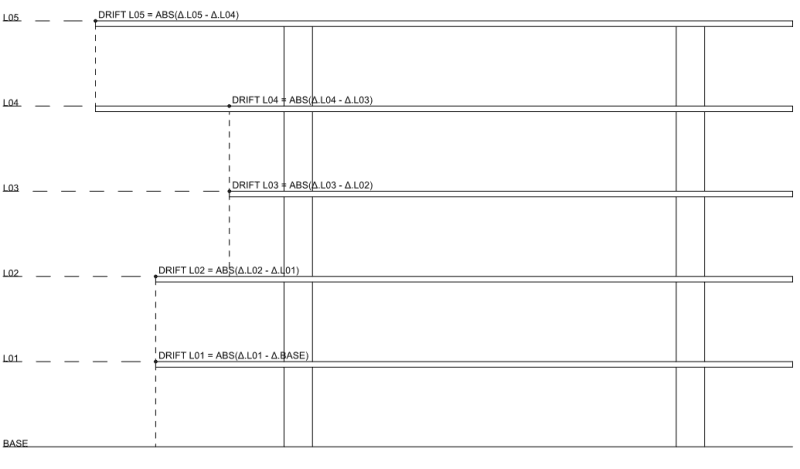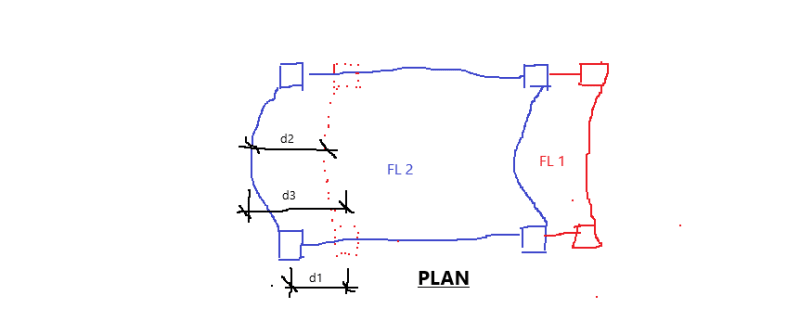I'll go ahead and start the arguments for/against but would still like for others to weigh in:
Arguments FOR including the diaphragm deflection
[ol 1]
[li]
ASCE 7-16 11.2 definition: "STORY DRIFT: The horizontal deflection at the top of the story relative to the bottom of the story as determined in Section 12.8.6.[/li]It says "horizontal deflection"... why should we assume it only includes horizontal deflection of the vertical elements and not the deflection of the diaphragm?
[li]
ASCE 7-16 12.8.6: "Story Drift Determination. The design story drift (Δ) shall be computed as the difference of the deflections at the centers of mass at the top and bottom of the story under consideration."and also...
"the design story drift, Δ, shall be computed as the largest difference of the deflections of vertically aligned points at the top and bottom of the story under consideration along any of the edges of the structure."[/li] Wouldn't the center of mass of the a story diaphragm have diaphragm deflection included if it's in the middle of the diaphragm? Or for the other requirement, it doesn't only say "parallel to the edge", it says "along any of the edges"... "I can have significant diaphragm out-of-plane deflection at the midspan of my diaphragm at the edge of the structure"
[li] ASCE Figure 7-16 and section 12.3.1.3 introduces a term "Δ
ADVE" for the "average drift of vertical element". If this is the same as the story drift, why do they have two separate terms?[/li]
[li]"Nothing tells me I don't have to include it, so why wouldn't I?"[/li]
[li]What's the goal we're trying to achieve by limiting story drift? The general consensus seems to be the concern has to do with stability and P-delta effects on vertical gravity load-carrying elements (columns, bearing walls, etc) and limit damage/cracking of non-structural elements. Given that, what good is only paying attention to the drift right next to lateral elements if there's significant lateral movement in between? Where's the guidance on what's allowed if it's not limited with the story drift?[/li]
[li]"Not including it is dumb. You're saying I can put a really stiff shearwall at the center of mass and at the edges and everything else in between doesn't matter by code?"[/li]
[li]"Why would ASCE 7-16 Section 12.12 'Drift and Deformation' include 12.12.2 about Diaphragm Deflection? Clearly drift/deformations/displacements/deflection are pretty much being used interchangeably"[/li]
[li]Various examples that say it does... for example, page 45 of
[URL unfurl="true"]https://www.woodworks.org/wp-content/uploads/design_examle-Design-Example-of-a-Cantilever-Wood-Diaphragm.pdf[/url]: says "Drift consists of three components: diaphragm translation and diaphragm rotations from wall displacements and in-plane diaphragm deformations, as shown in SDPWS Figure C4.2.5B. Drift ∆ =δTranslation+δRotation+ δDiaph
The deflection from translation and rotation are based on the response of the shear walls under the rigid diaphragm assumption"[/li]So this is for a cantilever diaphragm, so it's unclear if the same equation would apply to a normal simple span diaphragm, but why wouldn't it? The check given is at the maximum condition including the maximum effect of diaphragm deflection (rather than the center of mass as stipulated by code), so why wouldn't we be interested in the maximum condition in a simple span? I believe there are more examples others found yesterday too, will post later if I find them...
[/ol]
Arguments AGAINST including the diaphragm deflection
[ol 1]
[li]"Nothing tells me I have to include it, so why would I?"[/li]
[li]ASCE 7-16 Figure 12.8-2 seems to only be focused on frame deflection[/li]
[li]"Drift is only the vertical elements, not displacement. ASCE 12.8.4.3 talks about the average of "displacements" of the ends of the building. If that was the same as "drift" why use two different terms?"[/li]
[li]"Why would ASCE 7-16 Section 12.12.2 talk about Diaphragm Deflection limits on their own if they wanted it included in the drift?"[/li]
[li]"The story drift requirements include a Cd amplification factor on drift that is dependent on the vertical system. Why would the amplification on the diaphragm deflection be different for different vertical systems if they're the same diaphragm in two different structures?" (Response: because you already reduced the forces for R based on the vertical system, so they're basically make you undo that reduction."[/li]
[li]Internet sources like:
[URL unfurl="true"]https://www.woodworks.org/wp-content/uploads/DE-Panelized-Roof-Seismic.pdf[/url] (interestingly also from woodworks) that in the example on page 32 says: "It is worth mentioning here that diaphragm deflection is not included when evaluating the story drift limits of aSCE 7-10 Section 12.12.1. These limitations on building drift were developed primarily for the classic flexible frame system with a rigid diaphragm to prevent excessive distortion within the plane of the frame or shear wall. in masonry and concrete tilt-up buildings, these vertical elements deflect very little in-plane, with the bulk of translation occurring at other elements. The story drift limits of the building code do not apply to the diaphragm deflection."[/li]
[li]SEAOC Blue Book article here:
SEAOC BlueBook – Seismic Design Recommendations Tilt-up Buildings Mostly the entire page 14 can be summarized with "Story drift limits do not apply to diaphragm deflection."[/li][/ol]
So with these arguments in play, what does everyone think?
In terms of persuasiveness I tend to fall in the "for including it" until I saw the SEAOC source that I feel is tough to argue with since it's so boldly definitive...
The one thing I'm certain of is that the code should be much clearer on what they want.


![[smile] [smile] [smile]](/data/assets/smilies/smile.gif)

